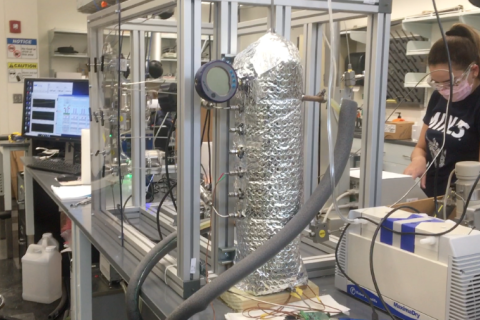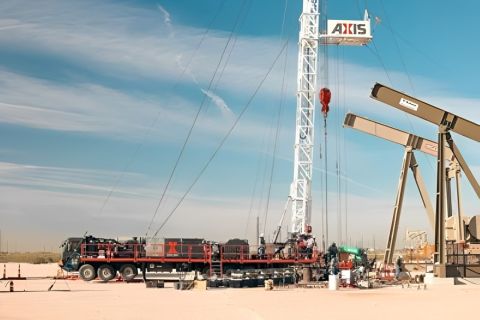Return on capital employed was the mantra chanted by nearly every executive speaker at the 28th annual investment conference of Howard, Weil, Labouisse, Friedrichs in New Orleans this year. Each year a theme emerges at the conference, and that was it this time. Attendance was relatively flat with last year, but as Howard Weil president Bill Walker noted, there were many new faces in the investor crowd. They heard a new song from both E&P and service company presenters: positive and/or growing cash flow is no longer enough. The importance of free cash flow was proposed by A.G. Edwards last summer. Analysts at Petrie Parkman & Co. also wrote about the topic, as seen in last month's issue. "Destruction of capital will no longer be tolerated," said its report. "Although cash flow evaluations are inherently misleading, we believe they will still be used...We also believe investors want economic return on capital, not just a cash flow multiple. To accurately value theses stocks, we suggest a net asset value-based calculation sensitive to creation and destruction of value." Simmons & Co. International, for 25 years a leader in analysis of the service and supply group, recently inaugurated coverage of the E&P world by issuing a major report in which it, too, proposes that we all look at something other than cash flow. Simmons' E&P analyst, Mark Meyer, thinks it's time to evaluate companies on a more traditional price-to-earnings model the way other industries do. The frightening thing is that on that basis, many of the 18 larger E&Ps under his watch appear to be fairly valued, not undervalued. "The right analysis should be full-cycle analysis, which includes the cost of capital and minimizes accounting distortions. Earnings are not perfect but they do capture some of the cost of capital. Admittedly, E&P is a very tough business that requires significant discretionary cash flow spending to replace depleting reserves," Meyer says. "It is difficult to synchronize spending with cash flow that varies due to volatile commodity prices. But why own these stocks if value is destroyed?" Much of the new thinking can be traced back to the EVA concept (economic value added) that was started by consulting firm Stern Stewart & Co. In the last three years, more companies and analysts are using EVA in their work. Beyond focusing on rates of return, it was noteworthy that several companies at Howard Weil spotlighted new business initiatives related to e-commerce. To bring yourself up to speed on that score, be sure to read our supplement attached to this issue, "Online E&P Marketplace," in which we identify the trends and profile some companies moving e-commerce forward in the upstream world. There are now close to 45 such web sites, with more being announced since we sent that publication to the printer. The investment banks have taken note of the trend, too. Says Tyler Dann of Banc of America Securities in a major report, "E-commerce, and broader e-business applications (workflow process services in addition to the transaction platform of e-commerce) have the potential to be the oil industry's next leg of major cost savings. Estimates of potential savings vary from 5% to 30% of existing costs. However, it likely will also have the power to destroy traditional sources of competitive advantage." Kudos to Salomon Smith Barney analysts Geoff Kieburtz and Mark Urness for their new report, whose title, "Bubba-2-bubba," wins our award for best title of the year. They also detail the explosion of business-to-business web sites for the upstream industry, from which they estimate annual cost reductions of just 3% could yield $4- to $6 billion in industrywide benefits. "We expect tremendous efficiency gains in transaction administration. Traditional service companies do not appear threatened; however, the first-mover advantage will be critical. Furthermore, we believe brick-and-mortar infrastructure will be a key strategic asset," they say. They cite Schlumberger, Smith International's Wilson Supply unit, and National-Oilwell as major service companies that are already implementing e-commerce strategies. The same day their report arrived here, the wire services reported that 14 majors and suppliers have established a to-be-named e-commerce site in which they will buy and sell goods and services, from paper clips and computers to drill pipe. BP Amoco and Shell are key participants. Sooner Pipe & Supply, a mainstay for years in this business, also has unveiled its web site created so that customers may order and track oilfield tubular goods through the Internet. Shell Oil and The Beacon Group have launched a joint venture to invest in technology. Chevron by itself has a new technology venture capital unit-and two web initiatives.
Recommended Reading
Going with the Flow: Universities, Operators Team on Flow Assurance Research
2024-03-05 - From Icy Waterfloods to Gas Lift Slugs, operators and researchers at Texas Tech University and the Colorado School of Mines are finding ways to optimize flow assurance, reduce costs and improve wells.
Axis Energy Deploys Fully Electric Well Service Rig
2024-03-13 - Axis Energy Services’ EPIC RIG has the ability to run on grid power for reduced emissions and increased fuel flexibility.
Defeating the ‘Four Horsemen’ of Flow Assurance
2024-04-18 - Service companies combine processes and techniques to mitigate the impact of paraffin, asphaltenes, hydrates and scale on production—and keep the cash flowing.
TGS, SLB to Conduct Engagement Phase 5 in GoM
2024-02-05 - TGS and SLB’s seventh program within the joint venture involves the acquisition of 157 Outer Continental Shelf blocks.
2023-2025 Subsea Tieback Round-Up
2024-02-06 - Here's a look at subsea tieback projects across the globe. The first in a two-part series, this report highlights some of the subsea tiebacks scheduled to be online by 2025.





